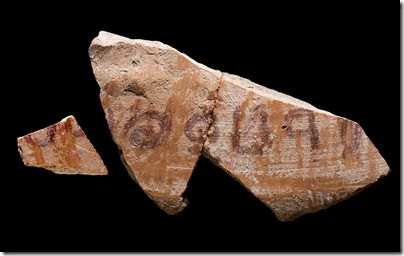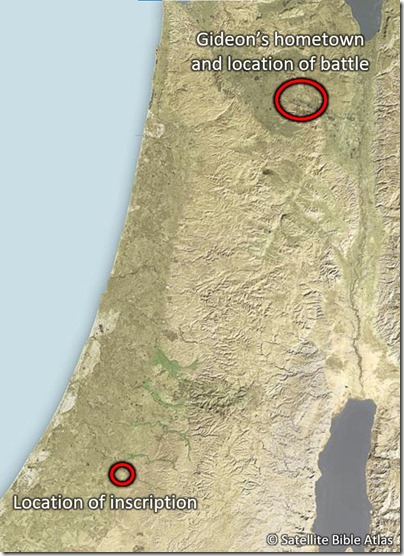Archaeologists have discovered an inscription with the name “Jerubbaal” at Khirbet al-Ra‘i in the Judean foothills, not far from Lachish. Jerubbaal was another name for Gideon (Judg 6:32). If the inscription can be identified with Gideon, this would be the first ancient inscription with the name of a biblical judge.
Jerubbaal inscription. Photo by Dafna Gazit and the Israel Antiquities Authority.
The inscription was published in the Jerusalem Journal of Archaeology (free pdf). Stories have been published in The Times of Israel, The Jerusalem Post, Haaretz, Bible History Daily, and elsewhere. The IAA has posted a 1.5-minute video (in Hebrew). The following is my summary of the main points.
The Sherds: Three pottery fragments were discovered with letters written in brown ink. Two of the sherds join together, but the third does not and its relationship to the other two is unclear. The sherds came from a small jug whose broken pieces had been swept into a stone-lined pit.
The Archaeologists: The excavations at Khirbet al-Ra‘i are directed by Yosef Garfinkel of the Hebrew University, Sa’ar Ganor of the IAA, and Kyle Keimer and Gil Davies of Macquarie University. The lead writer of the journal article is Christopher Rollston of George Washington University. Luke Chandler is credited with organizing a team of volunteers.
Date: The inscription is dated based on its stratigraphical context, pottery typology, and the shape of its letters to the late twelfth or first half of the 11th century, or approximately 1100 BC. This is approximately the time of Gideon. This is also the first Iron Age I inscription found in the Shephelah.
Language: The inscription was written by a trained scribe from right to left. The article’s authors identify the language as “Proto-Canaanite” or “Early Alphabetic,” in part because of their dubious assumption that Hebrew did not exist this early in history.
Baal: Two other inscriptions with the name “baal” have been found in the Shephelah in recent years. The Eshbaal inscription was discovered at Khirbet Qeiyafa, and the Baal inscription was unearthed at Beth Shemesh.
Jerubbaal: Four letters can be read clearly, reading rb‘l, equivalent to “rubbaal.” The initial letter is not fully preserved, but it may be a yod. If so, this would be the first discovery of the name Yrb‘l (Jerubbaal).
Is this the biblical Gideon?: The article’s authors raise the possibility but do not come to a conclusion either way. Here are some factors in favor of each position:
In Favor of Identifying with Gideon:
- Name: There is a possible match between the name on the potsherd and the name given to Gideon. There are no other people known from the ancient world with the name Jerubbaal.
- Date: This ostracon dates to the time of the judges, but it is difficult to know how close it is to Gideon’s day, because (1) the dating of the inscription is not precise; (2) the dating of Gideon’s judgeship is uncertain. Eugene Merrill dates Gideon to approximately 1180-1140, while Andrew Steinmann dates him to 1172-1133. If the inscription is truly from 1100, it is a few decades too late. In that case, perhaps the individual in the inscription was named after the biblical figure.
Against Identifying with Gideon:
- Geography: All of Gideon’s known activity was in northern Israel or Transjordan. The southern Shephelah where this inscription was found is too far away. The tribe of Judah is never mentioned in the context of Gideon’s life. All of the biblical judges served in particular regions; there is no reason to believe that Gideon had a national ministry.
- Patronymic: Though no other men named Jerubbaal are mentioned in the Bible, it is possible that there were men with this name at this time. If the sherd had included the name of Gideon’s father (Joash), that would make an identification more compelling.
- Incomplete: The initial letter is fragmentary and may not be “J” (yod). It is also possible that there were other letters before or after that have not been preserved. In other words, the name may not be Jerubbaal. Haggai Misgav suggests the name could be Azrubaal. Other possibilities from names known from the ancient world include Zekharbaal and Merib-baal (1 Chr 8:34).
Conclusion: This discovery is valuable because inscriptions are rare in the land of Israel at this time. The potential connection with Gideon’s alternate name, and the proximity of the date, makes the identification possible but by no means certain.
Location of discovery of “Jerubbaal inscription”; map from the Satellite Bible Atlas

